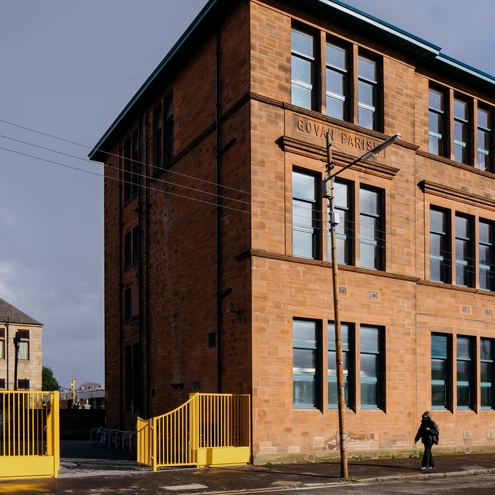Project showcase
Kinning Park Complex, Glasgow – Kinning Park Complex SCIO with New Practice

This community-owned space services locals in various ways such as the drop-in cafe, events and learning opportunities - as well as conferences, sports classes, cultural events, and bustling community meals twice a week. Mobility and access have informed the new designs to champion inclusivity. “What-if” conversations and “baggy” spaces hope to ensure flexibility for the future as the community continues to evolve.
Who is on the project team?
Architect: Becca Thomas, New Practice
Principal designer: Hunter Kirkpatrick, Armour Construction Services
Main Contractor: Michael Scanlan, Clark Contracts
Services Engineer: Duncan MacLennan, Max Fordham
Describe the context of this project?
Kinning Park Complex (KPC) is a community-owned building in the Southside of Glasgow, steeped with rich history; it has been an ever-changing centre for education, activism, and protecting its local community for over a century. Back in 1996, the council, unfortunately, decided to close the facility. Local mothers who relied on the building for childcare joined forces with local campaigners - including First Minister Nicola Sturgeon - to occupy the building for 55 days, as a result the community was given a peppercorn rent of £1. The building was led into the new millennium under the care of a local resident, mother and campaigner, Helen Kyle’s organisation Scotland in Europe. Over the past 20 years, repairs and upkeep of the building became more expensive and challenging. The leadership team worked towards successfully purchasing the building with the support of a new piece of legislation, The Community Empowerment (Scotland) Act 2015, which would, in turn, allow for the organisation to secure funding to make the building a warm and safe community resource.
New Practice has been working with the leadership team at Kinning Park Complex SCIO since 2017 to develop a design and business proposal adding weight to their winning bid to National Lottery Community Fund Scotland for £1.2 million. In March 2019 additional funding from the Scottish Government’s Regeneration Capital Grant Fund secured the future of Kinning Park Complex and the building’s redevelopment.
Tell us what you did and how the project enlivened the place?
Retaining the building’s heritage and the existing structure was key to the design of new functional, flexible and accessible community and creative workspaces across all three storeys. Adaptive re-use and internal reorganisation allow for the delivery and bolstering of valuable community events and resources - drop-in cafe, events and learning opportunities - as well as conferences, sports classes and cultural events. KPC building users include a high proportion of vulnerable users with accessibility needs from English as a Second Language to mobility needs and health concerns. To help with this a new passenger lift was installed and, critically, the lift is complimented by a new ramp to the secondary entrance ensuring level exit and entrance for everybody.
The revamped interiors are animated by a system of colour-blocking, which helps to ensure people of all literacy levels can easily navigate the building. Each of the three floors use a different, bold colour to help with wayfinding: salmon pink, a yolky yellow, and a green bordering blue. With the same down-to-earth practicality found elsewhere, the paint colours are standard Dulux shades that won’t go out of stock. Additionally, a new Quiet Space which will act as a multi-purpose support space for a range of uses, including: prayer; breastfeeding; quiet space for neurodiverse building users and break out/thinking space has been added to the project. On the top floor there are a range of different studios for artists and like-minded social enterprises in part to generate some income for Kinning Park Complex
Did the project make a positive social and environmental contribution?
KPC has long been a champion of doing more with less: working across communities to support reuse and repair of items over buying new; cooking meals for hundreds weekly with vegetables grown in their own garden; and, working to support those hit hardest by austerity measures and political game playing.
For the organisation, the approach to redevelopment needed to match this spirit. From early conversations it was also clear that the character of the building was important to its service users, and that any redevelopment works would not be to create a white box, or a sterile space. To that end our sustainability goals began as a goal to reuse as much of the building fabric and finishes as possible before expanding to include upgrades to services, existing building fabric, insulating the roof space, energy production through a new PV array and expanding the community garden.
Sustainability at KPC is about the building and its metrics as a way to bolster and support the social and cultural capital that the organisation has developed since first taking the keys to the building in 1996.
Although we used natural gas, this replaced an ageing oil boiler which we estimated would reduce CO2 emissions associated with heating and hot water by 30-40%. New heating and hot water controls will reduce energy use while improving comfort. PV arrays are also installed. New LED lighting and lighting controls will help reduce energy use associated with this.
Festival of Pineapples
24-26 February 2026
Pineapples prize giving night
April
Pineapples at Festival of Place
10 June 2026
© The Pineapples - Tweak Ltd. 124 City Road, London, EC1V 2NX. Tel: 020 3326 7238




